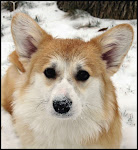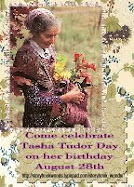
For some of this, I will refer to Deborah Harper's book "The New Complete Pembroke Welsh Corgi." Sadly, this book is out of print but you can sometimes find a copy on eBay. It has a wealth of information as well as interesting back history and bloodlines that have had their mark on our breed. Maybe if we all beg Debbie she will tell her publisher that it is time for an updated version. I'd be first in line to buy it. Debbie is not only a lovely friend but an awesome mentor. I always learn so much from her and it is most comforting to know she is always there when puppies are about to be born. The Tasha Tudor illustration above, the black and white photos for correct paw fur trimming which will be in my next post as well as quoted material from her book is used here with permission. The color photos were quickly taken over the weekend by Mary Elizabeth and I.
Debbie writes: "We start at the back end of the dog, at the very bottom of his pants, and work up over his back and sides to the front and end with the chest coat. An English fine comb or a natural bristle brush is used, and the coat is worked from the skin out in the direction the hair grows. Be careful not to scratch the skin as you work. With a dense undercoat, only a very small section can be done at a time. Grooming the coat in this manner will get the undercoat and guard hairs all going in the same direction and will give a smooth, even, rich appearance to the coat. If the coat is full of static electricity, making it difficult to handle because of the flyaway hairs, dampen the coat slightly with a fine spray of water as you work. After all your efforts are done, the dog will give himself a good shake, letting you know he prefers to go dressed his own way..."
The first time you do this combing will probably be the most time consuming part of the entire grooming process. With regular combing and brushing, it will get quicker and easier as you practice. Once or twice a year, expect to have a pretty big shedding which will take a bit more time to handle.
 Hold up the fur with one hand and then comb in the direction the fur grows, inch by inch, with the other hand.
Hold up the fur with one hand and then comb in the direction the fur grows, inch by inch, with the other hand. The coat after line combing.
The coat after line combing. Some people train their dogs to lie down quietly on their sides as they are being groomed or combed out. I spent the day at Sue Jacob's (artist extraordinaire) painting yesterday (but that will be show and tell for another day's post!) Sue started grooming Corgis back in her days as a junior handler. Her dogs always look beautifully groomed. Sue gave me a few tips to share with you. She put Liat (her cuddly handsome sable boy) on his side and he was very happy to lay there for his pampering. After bathing, Sue towel dries the dog well and then after about 20 minutes starts the blow drying process. While blow drying, she is using her comb or pin brush (never one with 'balls' on the end, as she feels it tears the coat, but rather one like I described in my earlier post) and works through the fur in the direction of the coat. She starts with the dog laying down on his side, working around the turn of stifle, sort of line combing from the belly, up to the top. In addition to using a greyhound comb, Sue sometimes likes to use an even finer, almost a 'flea' comb as well as a soft slicker brush on each section as she goes along. After doing the sides, the dog stands up and she works the line from the tail to the head and around to the chest in the same manner.
Some people train their dogs to lie down quietly on their sides as they are being groomed or combed out. I spent the day at Sue Jacob's (artist extraordinaire) painting yesterday (but that will be show and tell for another day's post!) Sue started grooming Corgis back in her days as a junior handler. Her dogs always look beautifully groomed. Sue gave me a few tips to share with you. She put Liat (her cuddly handsome sable boy) on his side and he was very happy to lay there for his pampering. After bathing, Sue towel dries the dog well and then after about 20 minutes starts the blow drying process. While blow drying, she is using her comb or pin brush (never one with 'balls' on the end, as she feels it tears the coat, but rather one like I described in my earlier post) and works through the fur in the direction of the coat. She starts with the dog laying down on his side, working around the turn of stifle, sort of line combing from the belly, up to the top. In addition to using a greyhound comb, Sue sometimes likes to use an even finer, almost a 'flea' comb as well as a soft slicker brush on each section as she goes along. After doing the sides, the dog stands up and she works the line from the tail to the head and around to the chest in the same manner.There should be no scissoring or trimming of the Corgi anywhere on his coat other than on the pads of her paws in order to create a nice clean oval foot, which I'll share with you in the next post.
I've received all of your emails that you are printing out this little basic Corgi grooming series. As soon as I'm finished (we still have basic nail grooming, etc.) I will try and put them all together into a free downloadable file for you as soon as I figure out how to do it. If anyone would like to spare me the time trying to figure it out, do send me an email at christmascorgi@gmail.com and I will be most grateful.
Still to come: Pretty Paws and Nails and getting that Corgi coat healthy from the inside, out.













.jpg)









